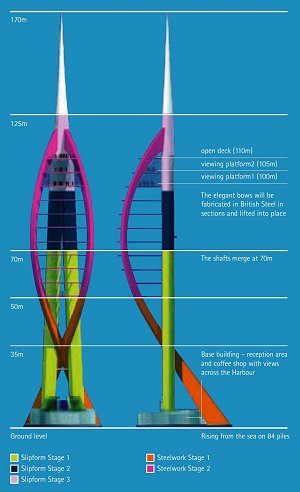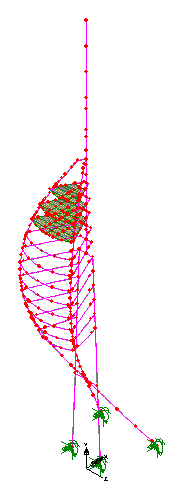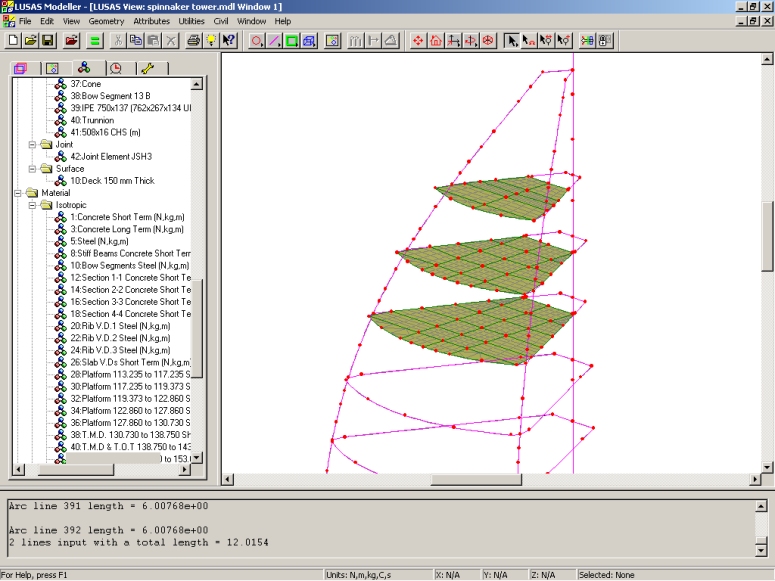Case Study
Share this
article
Spinnaker
Tower
-
Tallest public viewing
tower in the UK on completion
-
Concrete, steel
and composite construction
-
Category III check using
LUSAS static, dynamic and nonlinear analysis

The Spinnaker Tower is a
£35million, UK Millennium Commission sponsored project aimed at
transforming the waterfront of Portsmouth and Gosport. It forms
the focal point of a £200M regeneration of the Portsmouth Harbour
area and adds a new international landmark to the South Coast of
Britain. Designed by Scott
Wilson Advanced Technology group (now part of URS), LUSAS Civil &
Structural analysis software was used by its London office for an
independent Category III check of the original design for the
client Portsmouth City Council.
|
Overview |

Tower Construction
Stages |
- Spinnaker
Tower is a concrete, steel and composite structure that
rises 170m from the sea adjacent to Gunwharf Quays. It
has three tourist viewing platforms at heights of 100,
105 and 110m that offer extensive views over Portsmouth
harbour and beyond.
|
- It
is constructed upon a 3m thick pile cap and founded on
84 piles, and comprises two inclined slip-formed
hexagonal concrete shafts, of 6m across, which merge
into a single shaft at 70m. One shaft contains an
internal express lift and the other shaft carries a
panoramic external lift up the seaward face.
|
- Two
elegant crossed bows, fabricated from 10.8m long and
1.5m wide structural steel box sections, rise from the
ground, cross between the shafts at 35m and rise to
connect with the shaft at 120m. The bow dimensions vary
from 10-12m in depth at the base and top of the tower,
reducing to 2.5m wide in the central region. Aerofoil
shaped ribs span between the bows to give the
distinctive ‘Spinnaker’ sail appearance.
|
- A
composite spire forms the needle-like top to the
concrete A-frame.
|
Modelling
and Analysis
 Static,
nonlinear and dynamic analysis were all employed by Scott Wilson to
analyse the model of the Spinnaker Tower in LUSAS. Ship impact, wind dynamics,
wind-induced fatigue and the consideration of human perception of
wind-induced movements at observation deck level all needed to be
assessed in the design check. To do this, a model of thick beam and
thick shell elements was created and used as a basis for the three
distinct analyses that were carried out. In doing this the arbitrary
section property calculator built into LUSAS was particularly
helpful in deriving the section properties required for the varying
cross sections of the concrete towers and of the steel bows, and
helped to speed-up the building of the model significantly. Static,
nonlinear and dynamic analysis were all employed by Scott Wilson to
analyse the model of the Spinnaker Tower in LUSAS. Ship impact, wind dynamics,
wind-induced fatigue and the consideration of human perception of
wind-induced movements at observation deck level all needed to be
assessed in the design check. To do this, a model of thick beam and
thick shell elements was created and used as a basis for the three
distinct analyses that were carried out. In doing this the arbitrary
section property calculator built into LUSAS was particularly
helpful in deriving the section properties required for the varying
cross sections of the concrete towers and of the steel bows, and
helped to speed-up the building of the model significantly.
Load
cases analysed included self-weight, dead loads, live loads, wind
loads and various temperature differentials. Building services loads
were generally applied as uniformly distributed loads, with major
equipment applied as point loads. Wind tunnel testing provided the
wind forces to apply to the model. Differential temperature loadings
requiring detailed investigation included variations with respect to
the assumed erection temperature, differing temperatures of each leg
and for opposing faces of each leg, as well as differing internal
and external temperatures for the mast and for the viewing areas.
Long term creep and shrinkage was also investigated.
Mokhtar El-Houry,
Assistant Structural Engineer at Scott Wilson’s London office
said: "Spinnaker Tower is quite unique in its design and
required the use of finite element tools to accurately model its
behaviour. The original tower design was carried out by the Scott Wilson Advanced Technology team
based in our Basingstoke office - our involvement in the London
office was as Category III checkers. We essentially redesigned and
remodelled the tower independent of the Basingstoke office, and in
using LUSAS to do this further reinforced our position as
independent assessors."
Viewing
platforms
The tower provides three
high-level trapezoidal viewing platforms that vary in size from 18m
x 14m down to 12m x 4.7m for the highest open deck. A grid of
I-section steel beams span between the concrete tower, steel bows
and frontal rib beams at each level to support the 150mm thick
concrete floor slabs. Each platform was designed as a composite deck
with vertical vibration from crowd loading considered as part of the
design check.

Results
obtained
From
the results of the various LUSAS analyses it was shown that, despite
its uniqueness and the use of different construction materials, the
tower essentially behaves as a static/simple structure - results
from the nonlinear models matched very closely the results from the
slightly less well defined static model. Khaled Majdoub, Assistant
Structural Engineer in London office said: "Being able to check
the structure for nonlinear responses was invaluable especially when
dealing with a structure that has never been designed before. We
also found being able to model the dynamic response very
useful." In recognition of the importance of correct modelling
of these types of unique structures Mokhtar El-Houry added: "We
found the technical support provided by LUSAS on this project
invaluable. The support team were quick and eager to help and
furnished us with sound advice when approached."
Additional
information
Now complete, the Spinnaker Tower
is the tallest public viewing tower in the UK. It has a design life of 80 years and
attracts more than half a million visitors annually. The build cost of the project was shared
between three main financial contributors: the Millennium
Commission, Portsmouth City Council, and the
Berkeley
Festival Waterfront Company Ltd.

"We found the
technical support provided by LUSAS on this project invaluable. The
support team were quick and eager to help and furnished us with
sound advice when approached."
Mokhtar El-Houry,
Assistant Structural Engineer, Scott Wilson
Share this
article
Find out more
Other LUSAS Civil &
Structural case studies:
|
|
Software Information
|